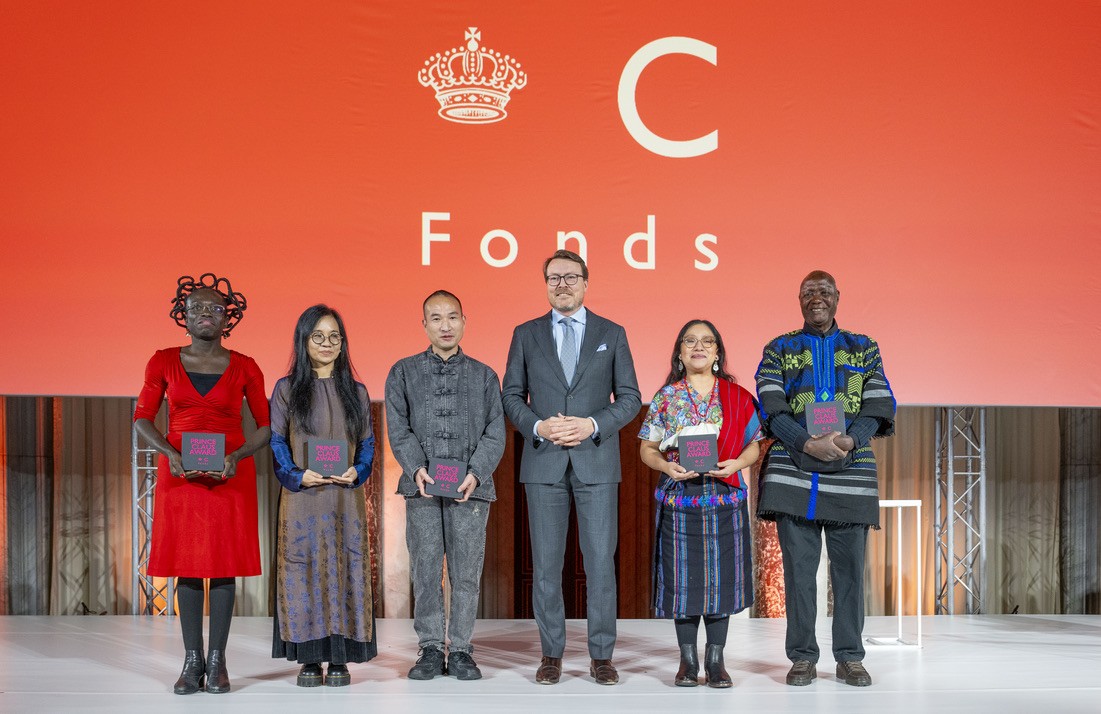Andrew Tshabangu – The Unsung Hero of South African Photography

10 August 2017
Magazine C& Magazine
Words Bongani Madondo
13 min read
In searing and poetic images, Andrew Tshabangu chronicles Johannesburg in the age of democracy.
Andrew Tshabangu’s two decades-plus visual repertoire, the best of which wasshowcased earlier this year at Johannesburg’sStandard Bank Gallery andGallery MOMO in Footprints, is provocative and ultimately liberating. With its exploration of blackness as a lived, if banal and mundane experience (just as it is with any other racial group), Footprints, which was curated by Thembinkosi Goniwe, is also notable for its simplicity and aching, often sweeping quietness, and clarity. In “The Value of Andrew Tshabangu’s Photography,” an essay in theaccompanying monograph, published by Fourthwall Books, the curator, critic and novelist Simon Njami tells us that Tshabangu’s journey began in the place where he was born, namely, South Africa. “While biography is never a trivial part of the analysis of any artist’s work,” Njami writes, “in Tshabangu’s case the contextual elements seem to render fundamental clues to a deeper understanding of his universe.”
Who is Andrew Tshabangu and why does he matter? Tshabangu was born in 1966 in Soweto, Johannesburg, where he currently works and lives. His lifelong visual subject is the city and its satellite township on the southwest frontier of the African megalopolis. Tshabangu studied photography in the Eastern part of the city, at the Alexandra Community Art Centre, in 1990; he later studied photojournalism at the Institute of Advancement for Journalism, shortly in the wake of the new democratic dispensation. He would go on to make his name as a photojournalist mainly at the then-exulted New Nation, an alternative weekly published by the South African Catholic Bishops’ Conference.

<figcaption> Andrew Tshabangu, Shembe Church Elders, from the series Bridges, 2008. Courtesy the artist and Gallery MOMO
“Without doubt,” writes Njami in Footprints, “a journey into the past is always necessary to get a better understanding of any photographic practice.” Njami then lets loose an obvious fact: “Tshabangu is black, and yet this biographical detail could seem almost irrelevant.” It isn’t—at least in the South African (or global) context. On March 21, 1966, six years before Tshabangu’s birth, the South African Police mowed down hundreds of unarmed civilians who weremarching peacefully in Sharpeville to protest against the Pass Laws. When he was ten years old, in June 1976, half of Soweto, and by extension the country, was engulfed in fire as students marched against thegovernent’s enforcement of Afrikaans as the language of instruction across the education system. The white regime again responded by shooting the youths and setting raging dogs on them. But, instead of heading into exile, like many teens slightly older than him who skipped the country at that time, Tshabangu, who grew up in a Catholic family, prayed and wished for inclusion in the one calling he felt would offer salvation to his tumultuous country—the priesthood.
Time would pass until he found other ways to tell and preach about the conditions of his people. Upon leaving high school, he applied to Wits University’s School of Dramatic Art, to study performance. “Alas, I was terrible at it. I was rejected, ” he told me recently. “And yet I kept on searching for ways I could train as a creative and tell my people’s stories. Hence I arrived at the Alexandra Community Art Centre where I took up taking up photography. It was not a complex decision to make.”
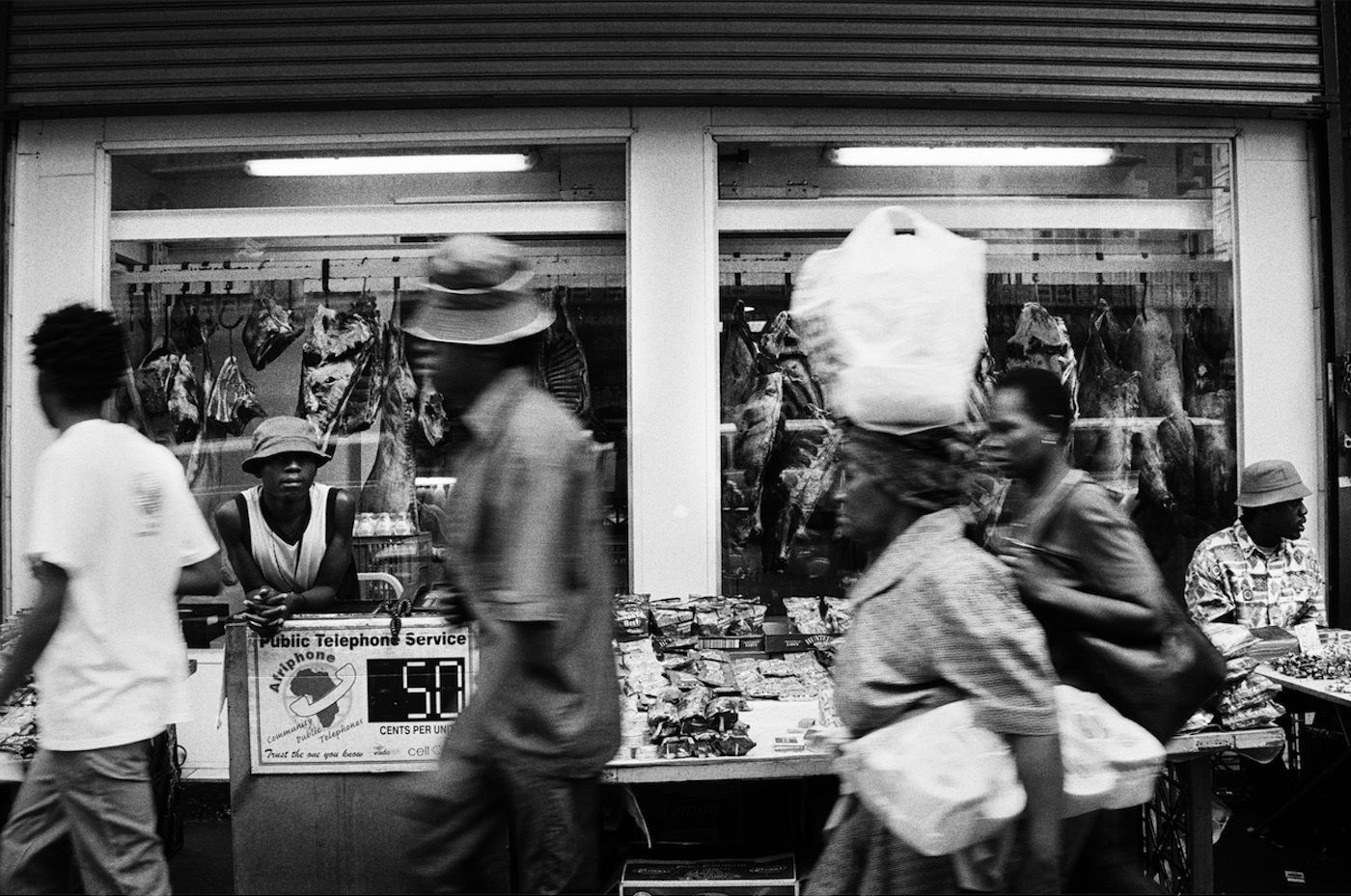
<figcaption> Andrew Tshabangu, Butchery, Traders and Taxis, from the series City in Transition, 2003. Courtesy the artist and Gallery MOMO
In a way, Footprints is both an accumulation, as well as a visual testimony, of the journey he has walked. Thematically divided into six chapters, “City in Transition,” “Bridges,” “Emakhaya,” “Hostel Interiors,” “Hostel Exteriors,” and “Water is Ours,” the exhibition and catalog comprise selections of Tshabangu’s photographs taken since 1994, a year of both personal and political resonance. The beginning of South Africa’s democracy, 1994 also marked the beginning of the end of foreign, NGO-supported African, feminist, and workerist independent media engaged in the antiapartheid movement.
Tshabangu is a survivor of that “struggle photography” culture spawned by the activist literary titles such as Staffrider, Weekly Mail, Labour Bulletin, New Nation, and Learn & Teach, and he is stoically steeped in the social documentary mode exemplified by Afrapix, acollective of politically-conscious photojournalists active from 1982 to 1991. His work refuses easy categorization and defies agitprop politics, while remaining cognizant ofhis subjects’ undeniable blackness; his project, per the Du Bois-esque adage, is the soul of black folks.
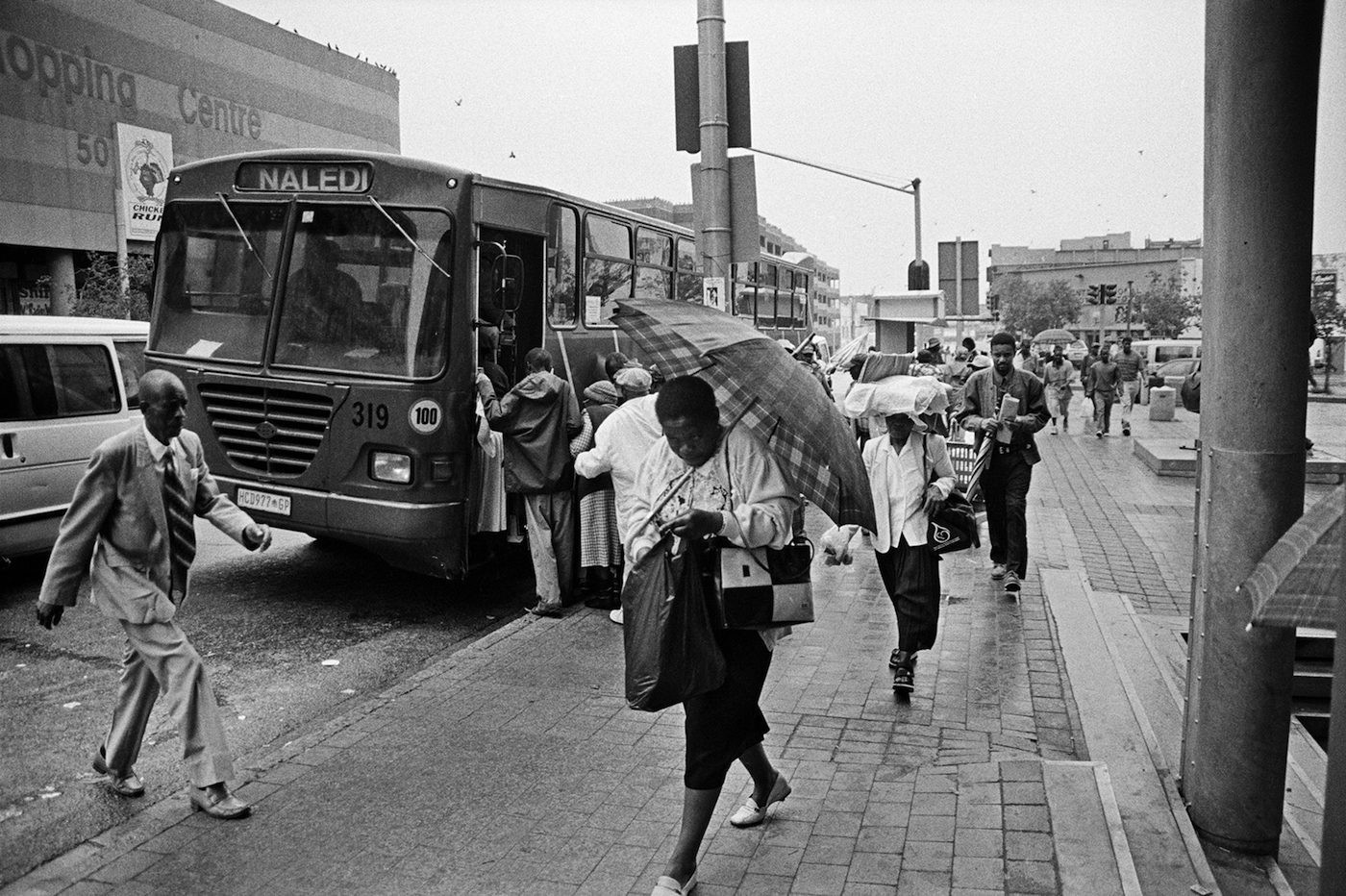
<figcaption> Andrew Tshabangu, Naledi-Bree Street Bus, from the series City in Transition, 2004. Courtesy the artist and Gallery MOMO
Stylistically, and by this I mean in terms of both aesthetic veneer and disciplinary strictures, Tshabangu can be said to have evolved within the social documentary genre. Early on, as testified by the section “City in Transition,” his camera was trained on black folks’ mobility—by taxi, train, or on foot—in and out of the city. Confident, he moved on to focus on a people dealing with the meaning of freedom via their age-old mysticism and African spiritual practices, before breaking out into the hostel dwellers’ digs and rural environs. By all intents, even in the post-1994 work displayed in Footprints, Tshabangu is a man of the 1980s, and in character and language, he appears stuck in there. There’s nothing extravagantly contemporary, hip, arty, current, or fashionable about his photographs, and yet his work is revolutionarily refreshing for its timelessness. It shouldn’t work wonders, but it does. There’s a backstory to this.
In the immediate postapartheid years, from 1994 to 2004, cultural spaces in South Africa metamorphosed from the tyranny of the apartheid-era single story—benign blacks doing nothing but enduring suffering from evil whites (when not burning everything in sight)—to an idealized narrative, One Nation Under a Groove. Of course, the entire project was optimistic at best and fictive at worst. Artists, the media, and the general public were exhorted to imagine the country anew. The process of re-imagining demanded of the newly democratic country to move the narrative from whowe are to whowe can be. In that period, the theory held that the past is a divisive if ugly country, a place we had better hurry to escape from, just in case it derails our march into cultural and social nirvana. Like all modern cultural and artistic expressions, photography as art or document found itself exposed and manipulated for propaganda purposes—this time propagating the RainbowNationGroove.
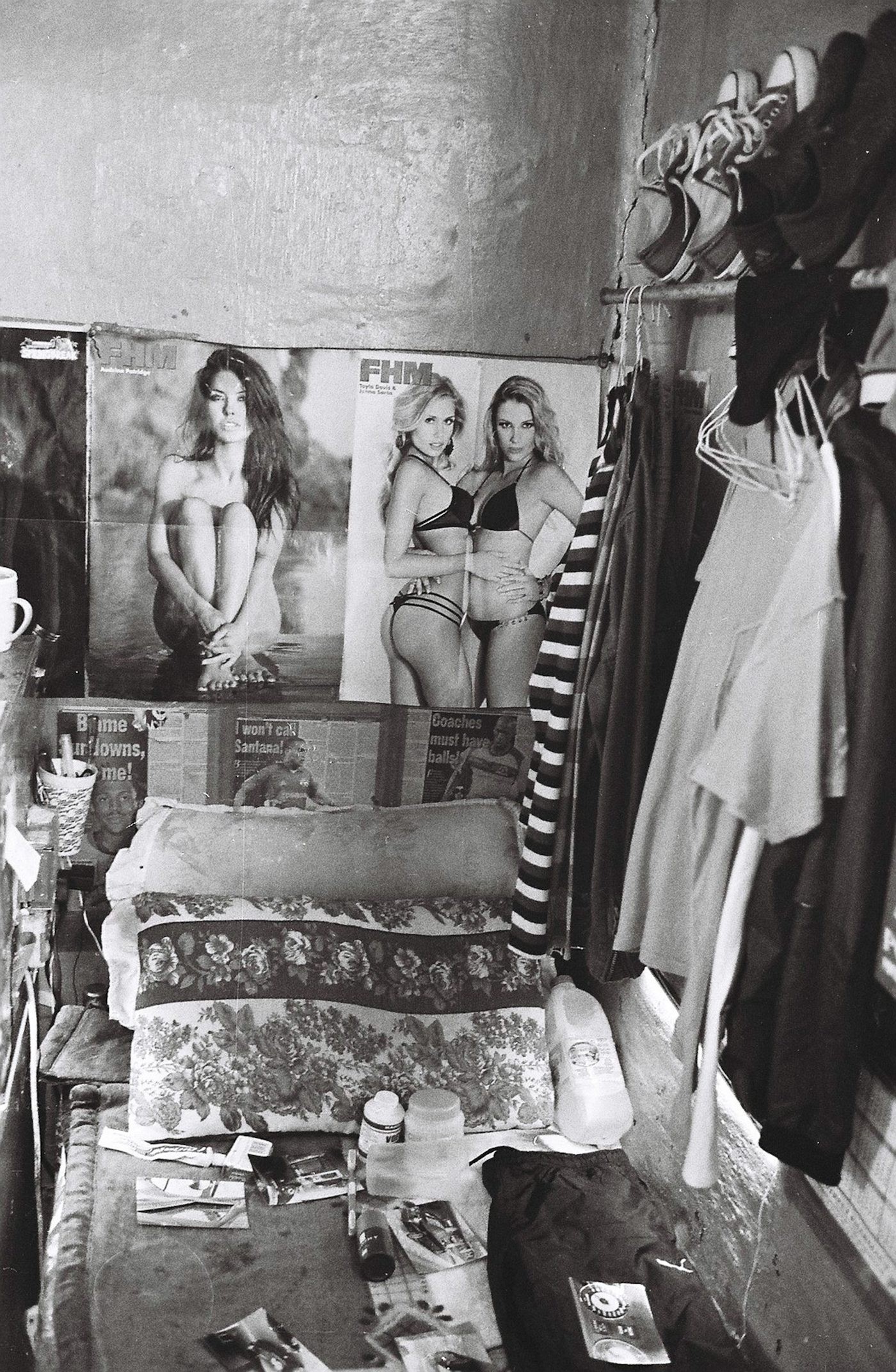
<figcaption> Andrew Tshabangu, Fantasy, from the series Hostel Interiors, 2009. Courtesy the artist and Gallery MOMO
In Tshabangu’s South Africa, the South Africa in his Footprints, photography, literature, and all modes of storytelling were no less besieged by the end of apartheid’s reconciliation project. Everyone was besieged. The new age of political correctness had arrived. Exhortations to ideological good manners grew all the louder. No matter what the economics and historical baggage your life might have been shaped by, the message was clear: You have to forget the past, you have to love thy neighbor, you have to believe in the untested miracles of the Nelson Mandela’s fantastical promise.
All attempts at wholesale loving and cultural kumbaya, with no solid legal or spiritual recourse to past injustices, kicked off with blistering immediacy in mid-1994. This is the era on which Tshabangu focused his lens. It was around this time that a question arose (with an implicit “nay” as its answer), a question that persists to this day, as galleries and commercial media wrestle with the conundrum: Does social documentary as a means of visual expression still matter? Is socially engaged art devoid of creative imagination? Is it propaganda?
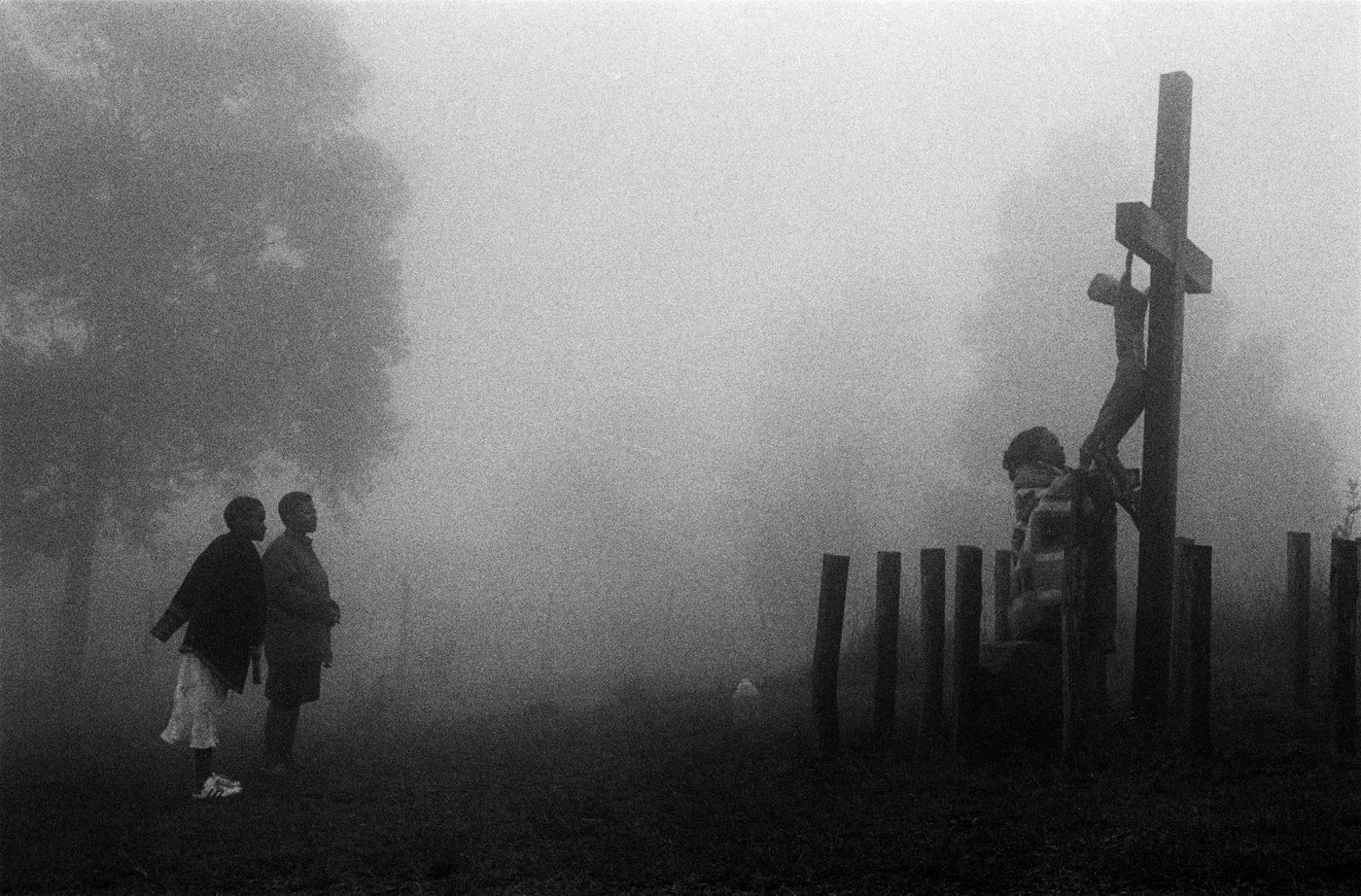
<figcaption> Andrew Tshabangu, Women Praying at the Crucifix, from the series Bridges, 2001. Courtesy the artist
Out of the cultural turbulence brought about by the politics of hope, social documentarians such as the Afrapix vanguard Omar Badsha, Paul Weinberg, Cedric Nunn, Santu Mofokeng, and Peter McKenzie, among others, all Ernest Cole’s affective heirs, were relegated—while simultaneously valorized by academic theorists—into museum fare and college syllabi. Only the newspaper- and street-hardened, photo-punk collective called the “Bang Bang Club”—which specialized in photographing the police’s jackboot behavior, the disruption of workers and church organisations work, random shootings and arrests of young black males, and the township youth’s militant response to it—achieved glorious infamy.
The “Bang Bang” crew—notably, Kevin Carter, Greg Marinovich, Ken Oosterbroek, and João Silva—were mostly white men working in the black townships. They were treated with suspicion, even though they were often the most reliable visual agents the burning ghettoes could hope for to beam tales of their daily woes to the outside world. (They were later immortalized in The Bang Bang Club [2010], a Hollywood flick that curator-critic Khwezi Gule eviscerates in his essay “Bureaucratization of Memory” in Okwui Enwezor and Rory Bester’s exhibition catalogRise and Fall of Apartheid [2013]. Gule calls out the photographers for “aestheticizing” as well as “commodifying” township folks’ suffering.) Through all these changes and aesthetic re-imaginations, Tshabangu pushed on quietly, alchemically, working through the raging trends, walking throughout the streets of Johannesburg, almost anonymously.
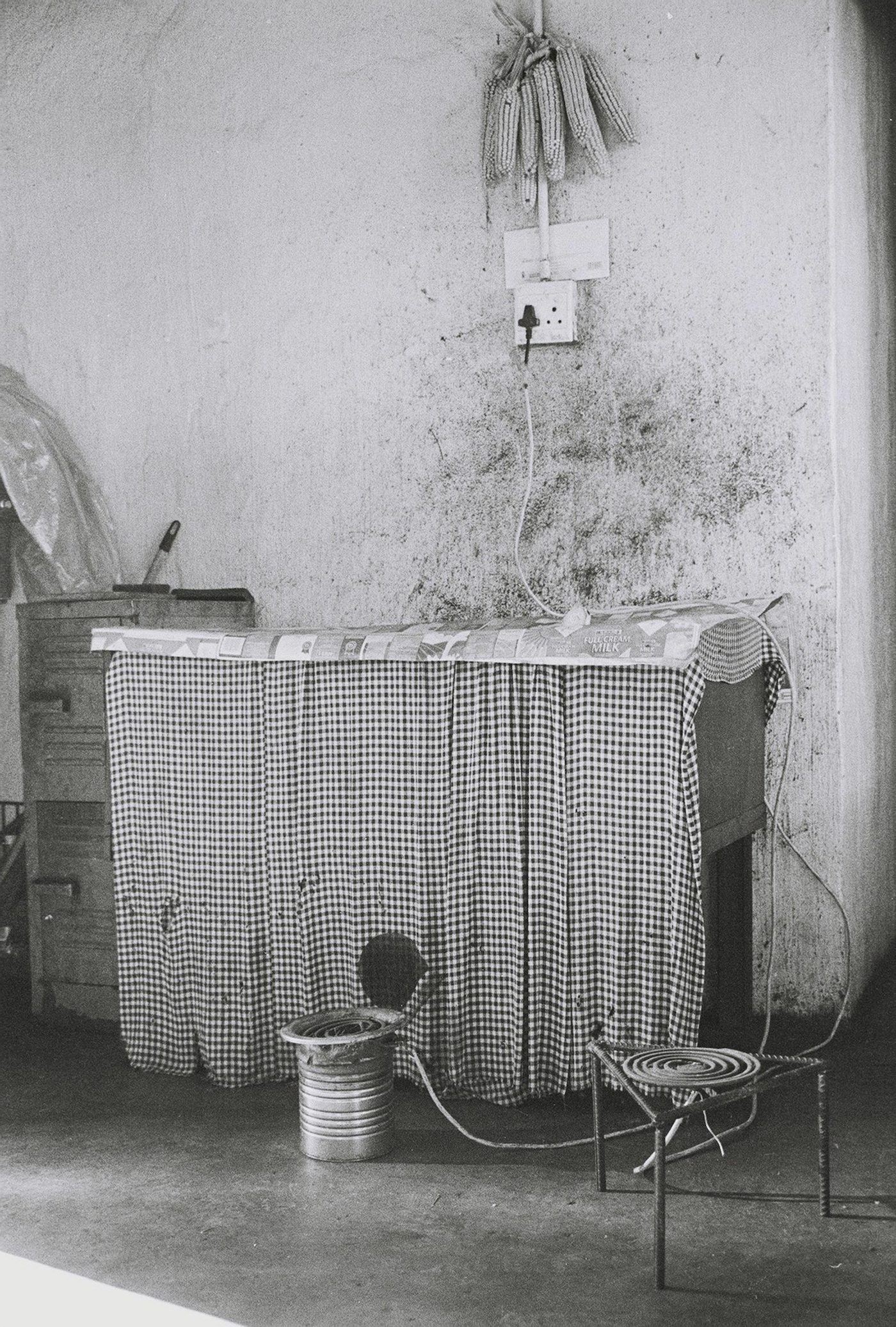
<figcaption> Andrew Tshabangu, Mielies, Stove and Heater, from the series Hostel Interiors, 2011. Courtesy the artist and Gallery MOMO
A twenty year survey (“and not retrospective,” Tshabangu insists), Footprints is perhaps the most fully realized and groundbreaking solo photography exhibition in South Africa in recent memory. Tshabangu circumvents all the cherished tropes of twentieth-century popular “black life” in Africa: sex, drugs, alcohol, cars, and witchcraft, or the joie de vivre of the stylized natives, as per Malick Sidibé’s postindependence nouveau noir aesthetic affirmation. Groundbreaking as Sidibé’sJames Brown-inflected portraiture (in West Africa) and some of Drum magazine’s 1950s shebeen and fashion show photospreads (in South Africa) were—especially to the racist gaze that never expected outward self-celebration and dandified genius from the native—ultimately that vision was, and is still, susceptible to the single story trap, too.
Tshabangu directs his camera to the same hard done Africans, street idlers, and Johannesburg’s legendary traffic-disregarding minibus taxis at the ranks, or in motion, though he chooses to show neither the ugly nor its opposite, poverty chic. Take, for example, his hostel series, subdivided into “Interiors” and “Exteriors.” His photographs of the exteriors of the low wage workers’ compounds entitled Hostel ExteriorI–IV (2008) give off an indifferent feel: trains of architecturally lackluster dwellings, windswept rows of laundry hung out to dry, no people in sight. In an interior view, Mielies, Stove and Heater (2011) depicts a kitchenette upon which stands a table decorated with a check-cloth covering, a bunch of mielies resembling a ponytail of a city slicker or Mafia hitman hung up above a whitewashed wall, and a long electric cord snaking around the table down to a makeshift tin stove that might work as both a tea-heating appliance or a DIY heater. It’s a stripped-down atmosphere: it’s minimalist without the trendy implication; here, minimalism implies a lack of material possessions, but also a willful commitment to “make it” by any means necessary.
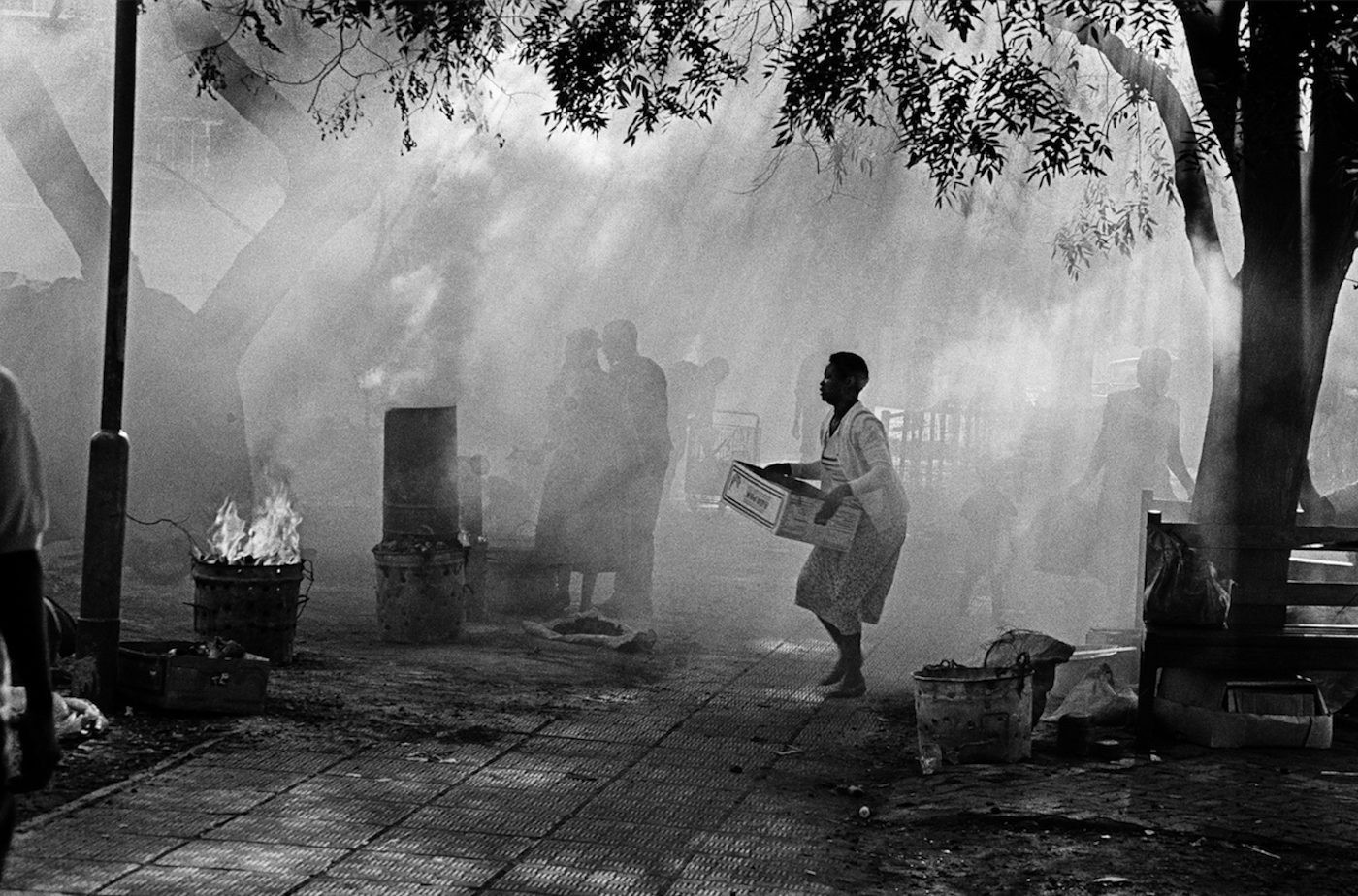
<figcaption> Andrew Tshabangu, Brazier, Joubert Park, from the series City in Transition, 1994. Courtesy the artist and Gallery MOMO
At the core of Footprints is a narrative of spiritual and ritual experience. The work speaks for itself like nothing else in current in South African social documentary. Why? The composition is specifically an oxymoron—motionless, mystical cinema, 1930s black-and-white Hollywood, a style reminiscent of Isaac Julien’s earlier work, and the process by which he hasrevisited his iconic film, Looking for Langston (1989), nearly thirty years later, with the emphasis on stills rather than video. There’s Tshabangu’s three-part series Brazier–Joubert Park (1994), which is is imbued with cinematic visual attributes. In the three frames, we see a random woman. She could be a grilled corn trader. She’s dashing across the frame carrying a random box. Behind her is a loose cast of several figures, figures almost blurred off under a haze of smoke, or cast behind a huge transparent smoke curtain. They are going about their interests, around open-fire braziers with raging fire emitting smog and additional smoke.
Brazier, Joubert Park is tricky, perhaps even throws up its own visual phantom jive. It’s as if, after printing it in the darkroom, Tshabangu continued to paint the cloud curtain of smog in it to trick the eye, or emotionally swindle us to connect with the image in a visceral way. Nothing could be further from the truth. Unlike the exuberant and performative visual language of say, Zanele Muholi, neither Tshabangu, nor his curator and gallery, are interested in moving the work from its reportorial grounding. That might seem to foreclose other readings, but, conversely, it also proves to be the only way Tshabangu’s magical realist work assumes its poetic potency, when not otherwise exulting in transcendental otherworldliness.
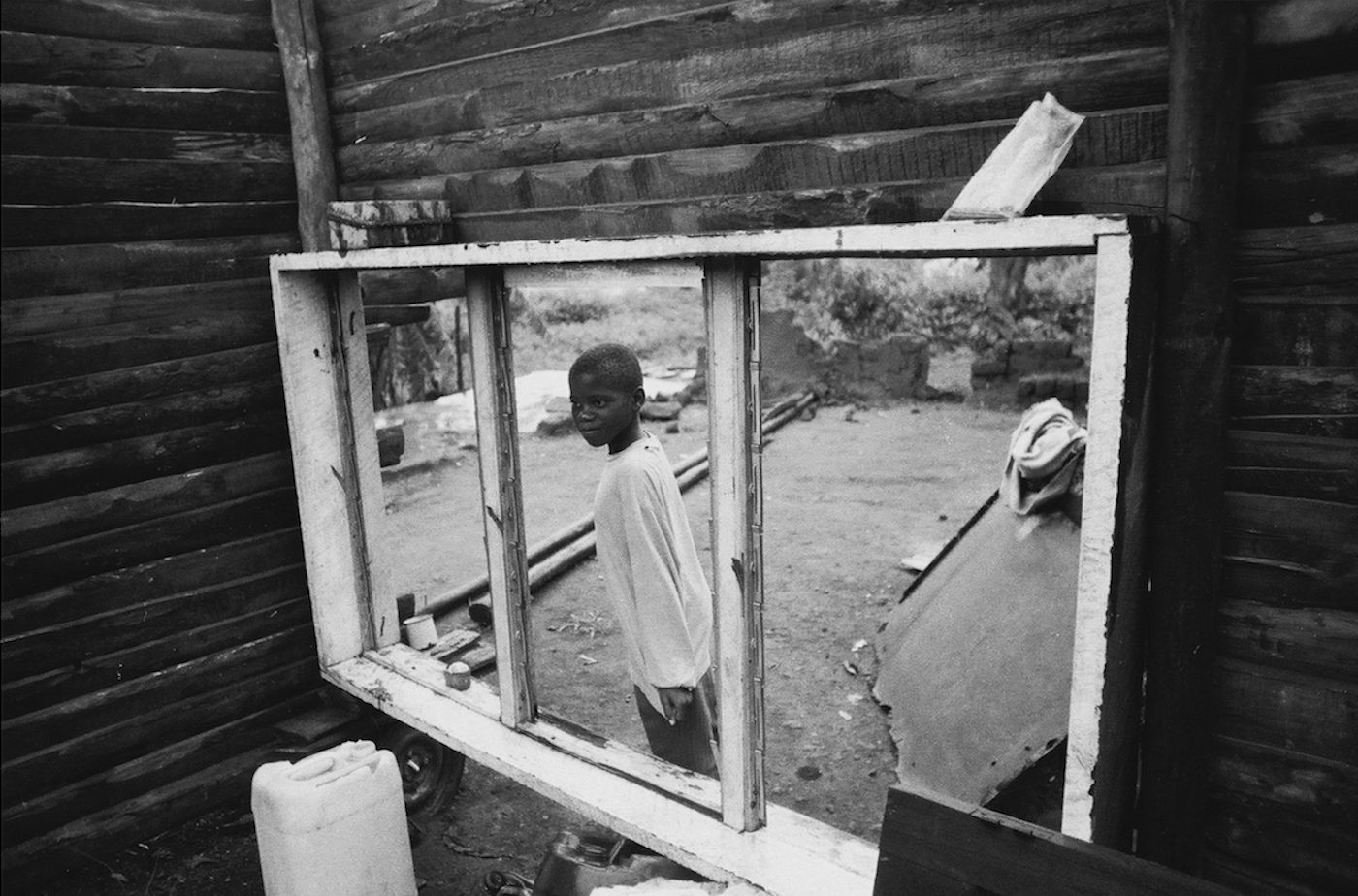
<figcaption> Andrew Tshabangu, Boy at the Window, from the series Emakhaya, 2004. Courtesy the artist and Gallery MOMO
Tshabangu grew up with ambitions of serving as an ordained priest. Instead, he might have become something else within that pantheon of the spiritual realm: the visual marabout. Haunted by this idea of humanity and dignity as something that can be imbued, passed on, gifted to, rather than an innate virtue and spiritual property, I revisited Footprints a month after it opened. The second time around, I started from the end and moved my way to the beginning, like loving backwards. Both the photographs as objects and the photographed spirits—shadows and figures, eyes daring the camera to get it wrong, or eyes trained far off beyond the horizons of the soul—are more than visual metaphors of a country. The work opens up like a flower, drawing the viewer into an omni-enfolded space from whence the bud, spurred by the gardener’s care and caress, reveals its secrets: bare, undemanding beauty. Which strains credulity, for what sort of beauty is undemanding? Yet, that is what bestows on Footprints its unimpeachable artistic and social gravitas. Tshabangu’s images pry the lid from our position as passive viewers. In other words, although we cannot simply swap places with his subjects, in looking at his photographs, we are participants, gazing at ourselves.
Bongani Madondo is the author, most recently, of Sigh, the Beloved Country (2016). He is an associate researcher at Wits Institute for Social and Economic Research, as well as contributing editor at the Johannesburg Review of Books.
Selections from Andrew Tshabangu’s series “City in Transition” are on view at Gallery MOMO, Cape Town, through August 20, 2017, followed by a presentation at Iziko National Gallery, Cape Town. The accompanying monograph was published in 2017 by Fourthwall Books.
This article is part of a series produced in collaboration with Aperture magazine, coinciding with Aperture’s summer 2017 issue, “Platform Africa.”
Read more from

The Re:assemblages Symposium: How Might We Gather Differently?
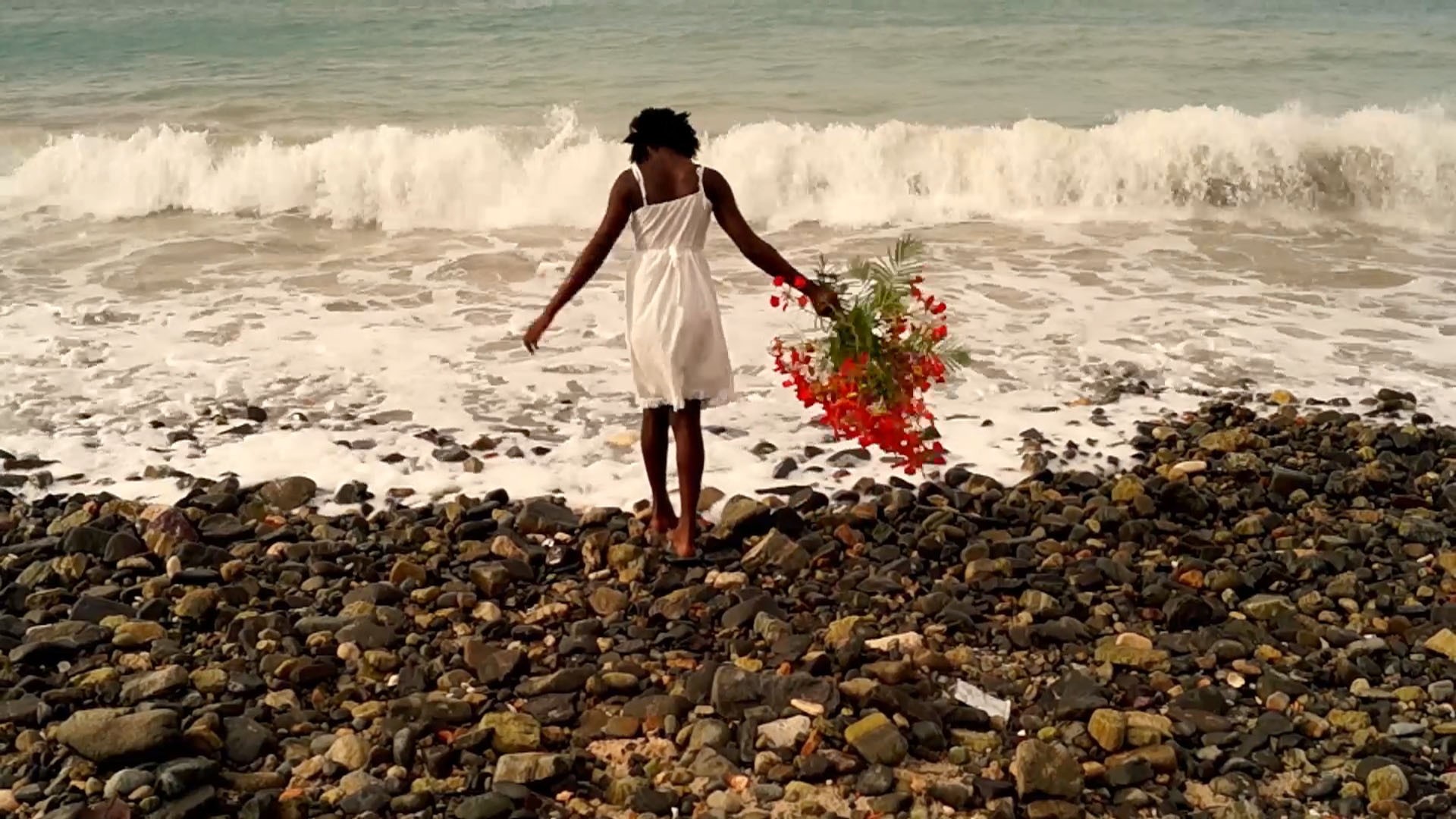
The Artists Forging Ecological Ties in Female Fugivity and Marronage

Werewere Liking: Of Spirit, Sound, and the Shape of Transmission
Read more from
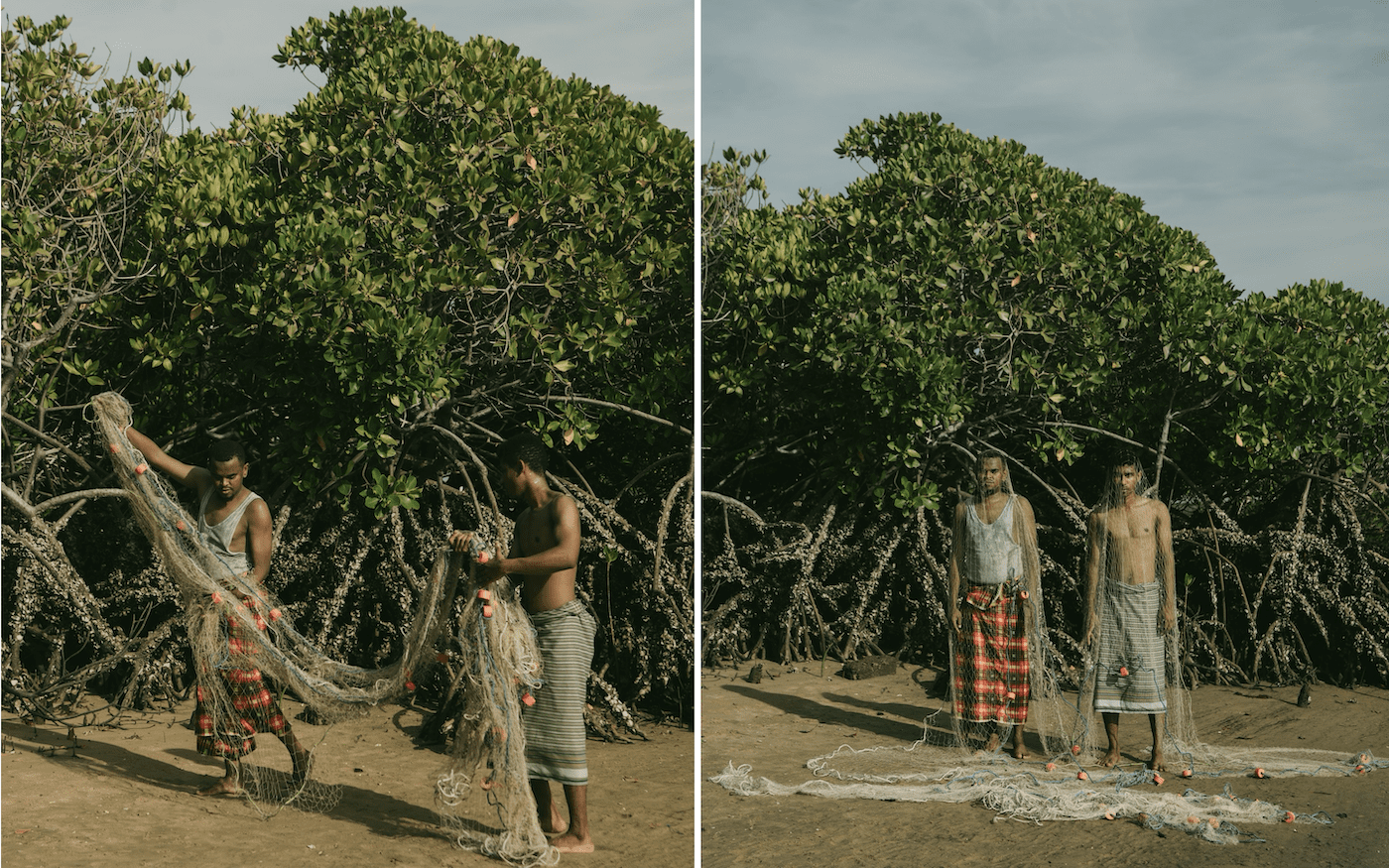
Mangrove Ecologies: Grounded Forms of Questioning in the Art/World
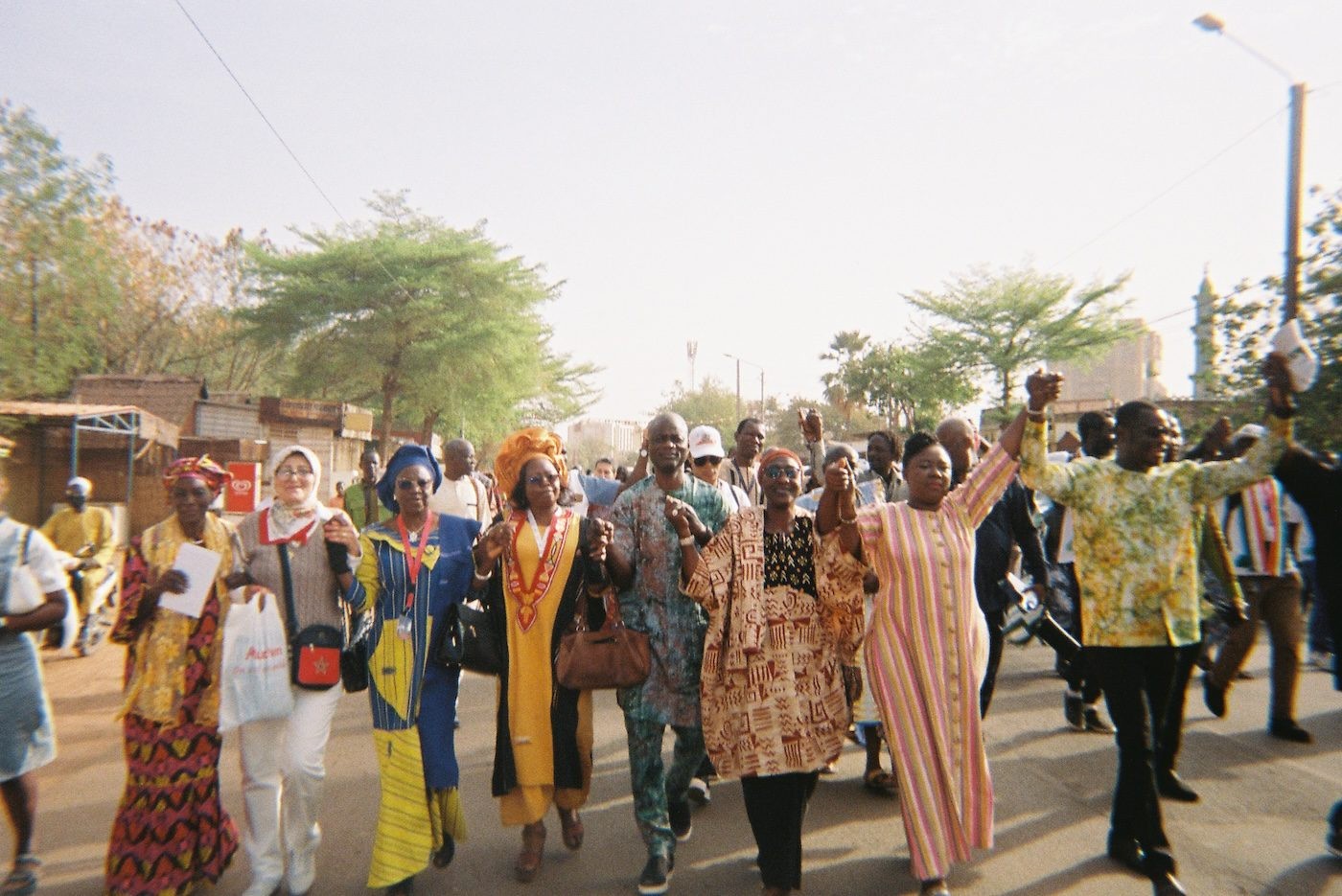
FESPACO 2025 Made Space for the Ceremony of African Cinema
